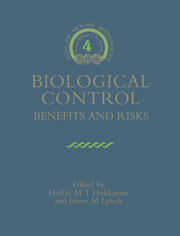Book contents
- Frontmatter
- Contents
- List of Contributors
- Series Preface
- Preface: Overview of Benefits and Risks of Biological Control Introductions
- Part I Biological Invasions
- Part II Classical Biocontrol
- Part III Augmentative Biocontrol
- Part IV Use of Genetically Modified Organisms
- Part V Economics and Registration
- 25 Development of the Biocontrol Fungus Gliocladium virens: Risk Assessment and Approval for Horticultural Use
- 26 Economics of Classical Biological Control: A Research Perspective
- 27 Economics of Biocontrol Agents: An Industrial View
- 28 Registration Requirements of Biological Control Agents in Germany and in the European Union
- Index
28 - Registration Requirements of Biological Control Agents in Germany and in the European Union
Published online by Cambridge University Press: 07 May 2010
- Frontmatter
- Contents
- List of Contributors
- Series Preface
- Preface: Overview of Benefits and Risks of Biological Control Introductions
- Part I Biological Invasions
- Part II Classical Biocontrol
- Part III Augmentative Biocontrol
- Part IV Use of Genetically Modified Organisms
- Part V Economics and Registration
- 25 Development of the Biocontrol Fungus Gliocladium virens: Risk Assessment and Approval for Horticultural Use
- 26 Economics of Classical Biological Control: A Research Perspective
- 27 Economics of Biocontrol Agents: An Industrial View
- 28 Registration Requirements of Biological Control Agents in Germany and in the European Union
- Index
Summary
Introduction
The number of plant protection products and active ingredients has been considerably reduced in Germany during the 5 years since the new Plant Protection Act (Gesetz zum Schutz der Kulturpflanzen) of September 1986 came into force. The number of registered plant protection products now amounts to 851 formulations with 216 active ingredients (18 August 1993, Fig. 28.1). The decline is a result of the consistent application of more stringent requirements for product registration.
In the coming years, the number of authorizations is expected to decrease further. Authorizations made before the Plant Protection Act of 1986 have expired and today's requirements for re-registration are tougher. Only about 25% of the plant protection products that were registered in West Germany in 1986, have already become subject to the new Plant Protection Act. In the new Bundeslander (Federal States) in eastern Germany, old registrations are valid until the end of 1995 with the exception of some products banned in Germany and some whose use is not acceptable. It is assumed that about 90% of them do not comply with the requirements for reregistration. Although the range of plant protection products has decreased in Germany, there was no marked effect on their usage until 1989. In the late 1980s consumption of active ingredients in West Germany amounted to about 36000 tonnes p.a., but dropped after 1989. About 33000 tonnes were sprayed in West Germany in 1990. In 1992 33 570 tonnes were sold in united East and West Germany, although the acreage nearly doubled after unification (Table 28.1).
- Type
- Chapter
- Information
- Biological ControlBenefits and Risks, pp. 283 - 290Publisher: Cambridge University PressPrint publication year: 1995
- 7
- Cited by



